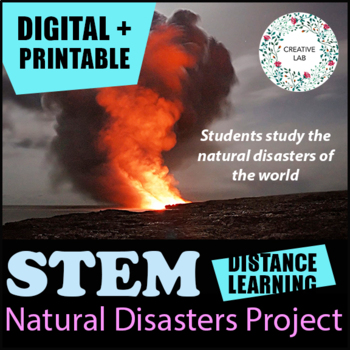Natural Disasters Hazards Research Project - PBL
- Zip
What educators are saying
Description
If you would like to purchase the 100% EDITABLE version of this product, click here! Great for differentiation!
Engage your students in studying the natural disasters of the world!
Natural disasters are naturally occurring events that negatively affect a large population of people. Natural disasters can unfortunately cause loss of life, as well as property, economic and environmental damage. Although by definition, natural disasters are ‘natural’, most scientists agree that human behavior also plays a role. Certainly, the more we understand natural disasters and their causes, the better equipped we will be in protecting human life. For this assignment, students choose a type of natural disaster to study and create a project to showcase their learning.
This resource guides students through conducting their own research report on a type of Natural Disaster (19 topics are listed). After choosing a topic to focus on, students are asked to conduct research using the Internet and books while following criteria. Next, students are asked to share their learning by creating a poster board, presentation board, PowerPoint presentation, or dodecahedron (Instructions and Pentagon Template included). A 3D model may also be constructed to further display learning. Finally, students present their work to the class. To help students choose a research topic (and to introduce the project to the class) we have included a PowerPoint that features the Top 10 Research Topics.
This Resource Contains:
★ Step-by-Step instructions
★ Research Instructions & Templates
★ How to Avoid Plagiarism Instructions
★ Dodecahedron Instructions & Template
★ 3D Model Instructions
★ Reference List Instructions
★ Example Photos
★ Student Self-Assessment & Rubric
★ Top 10 Research Topics PowerPoint
★ Access To Google Slides (Distance Learning)
How is this Resource Useful?
✔ Perfect end of term project
✔ Gives students choice
✔ High level of interest for students
✔ Perfect for differentiation
✔ Great for fast finishers
Project-Based Learning (PBL) is a student-centered pedagogy in which students are challenged to actively learn about a subject for an extended period of time. It is a form of active learning or inquiry-based learning. Project-Based Learning is in contrast to paper-based, rote memorization, or teacher-led instruction that presents established facts.
Thanks so much,
Creative Lab
More Like This:
Natural Disasters Project Craft - STEM PBL
Natural Disasters Project Bundle
Natural Disasters Project - Interactive Fans
Tags: natural disaster, natural disasters, natural disaster project, natural disaster projects, research project, science project, science fair, science fair project, stem, stem project, flood, floods, hurricane, hurricanes, tornado, tornados, tornadoes, volcano, volcanic eruption, volcanic eruptions, earthquake, earthquakes, tsunami, tsunamis, sink hole, sink holes, avalanche, avalanches, landslide, landslides, blizzard, blizzards, cyclone, cyclones, drought, droughts, thunderstorm, thunderstorms, hailstorm, hailstorms, heat wave, heat waves, wildfire, wildfires, solar flares, storm, storms, no prep, print and go, ngss, natural hazards





